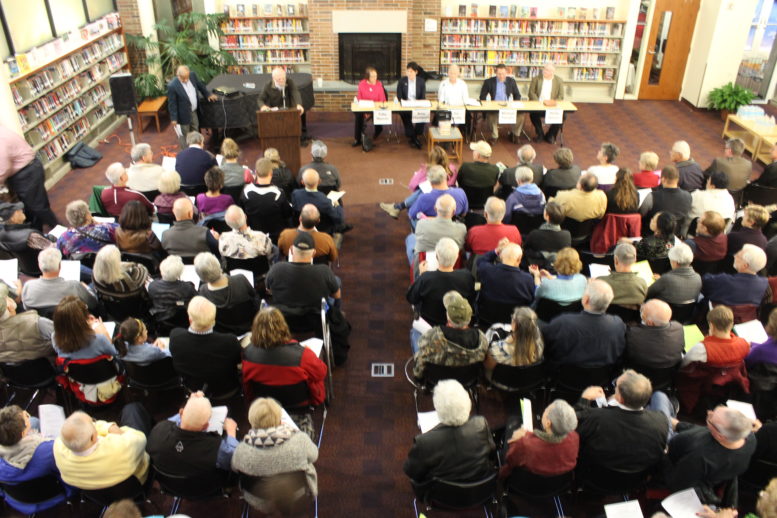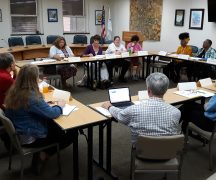By DAVID DUPONT
BG Independent News
Tom Klein opened the panel on gun violence Thursday night with a caveat. The panel, organized by a group of local residents concerned about gun violence, wasn’t as balanced as they had hoped.
They planned to have two representatives from those advocating the broadest gun rights, instead the panel had one, Michael Temple, a part-time NRA instructor. The NRA put the kibosh on the appearance of another representative, and the organizers’ attempts to find someone else proved futile.
So Temple was joined by Toby Hoover, founder of the Ohio Coalition against Gun Violence, and three academics who study aspects of gun violence.
Before the panel really got underway, though, it became evident that the beliefs in the audience of more than 120 would provide a counter to those of the majority of the panel.
Where’s the American flag, a man up front called out. Why no Pledge of Allegiance?
That us-versus-them attitude burst into full view after the panel had its say and the floor was open to questions.
The organizers were hoping for a dialogue not a debate. If there was any middle ground to be found in the atrium of the Wood County Public Library where the panel was presented, it was over the benefits of training.
Gun owners touted the value of training as did members of panel. But still they didn’t feel because some people didn’t bother get training or practice was no reason their rights to own a gun should be denied.
But those on the panel pointed out the limits of training. Even police who train and practice only hit the target 25 percent of the time.
And Phil Stinson, of BGSU who studies police shootings, said he’s struck by how many times in the incidents he looks at that police do not follow their training.
He said later that he suspects Post-Traumatic Stress Disorder, either from trauma experienced as a police officer or during military service, played a role in these incidents.
Still Temple asserted the value of the good guy with the gun, saying that those intent on mayhem pick soft targets that prohibit guns.
Amy Thompson, a public health researcher, said the problem with a good guy with a gun at a shooting scene is the police find it hard to distinguish the good guy from the bad guy.
Thompson compared all the regulations governing driving and all the mandated safety improvement to cars as opposed to the lack of the same with guns. What other product that is so deadly would be free of any regulations?
Temple said that “driving is a privilege” while owning a gun is an enumerated right protected by the Second Amendment.
The NRA was not opposed to gun safety measures. The NRA does not oppose research into and marketing of smart guns. The NRA does oppose making smart guns mandatory so that would be the only gun people were allowed to own or use.
And a woman in the audience said that it wasn’t her fault as a lawful gun owner if someone misused a weapon.
Thompson said that at times we need to consider the collective good.
“We’re all in this together,” Hoover later said.
Another audience member said background checks were useless because they don’t cover mental illness nor some state crimes, and that law enforcement couldn’t check them all.
Joe Jacoby, Bowling Green State University professor emeritus, sociology and criminology, said that the country’s elected representatives don’t provide police with the tools they need to enforce the laws.
Thompson noted that in Florida doctors are forbidden from discussing safety and guns in the home with parents. Congress, because of pressure from the NRA, forbids the Center for Disease Control to even research the effects of the presence of guns.
Temple said the pro-gun group was concerned the money would go to researchers who were biased. He said there are studies on the effect of guns out there, citing a researcher on a pro-gun site.
Jacoby said that just having a gun in the home creates vulnerabilities.
But the vulnerability several speakers were concerned about was of criminals bursting into their homes in the middle of the night intent on doing violence to them and their families.
Temple said in that case someone without a gun is going to have to call 9-1-1 and summon a police officer who is armed.
Thompson said 80 percent of burglaries occur during the day. Burglars just want your TV. Studies have shown, she said, that the level of violence goes up if the criminal is confronted with someone with a gun.
Hoover noted what’s more likely is someone in the household using the gun to kill themselves. And while other suicide methods offer some chance for rescue, guns kill. People who attempt and fail to commit suicide, rarely try again. For those who use guns, there’s no second chance.
One man talked about having his and his wife’s guns on the counter every night and nothing happens.
But Hoover wondered what happens when someone loses their job, or is diagnosed with a serious disease, or their spouse leaves them. They may have been fine with a weapon before, but what about now in their disturbed state? “Do you know anyone who is too disturbed to walk the streets carrying a gun?”
Hoover, whose husband died because of gun violence, said data is fine “but this is about people and families and children. We have more people dying than anywhere else in the world. We’re losing 100 people a day.”
But one man in the audience said there was more at stake. People needed to be armed to protect against government tyranny. That was the reason for the Second Amendment. The worst thing that could happen, he said, was losing that freedom.
Hoover disagreed. Anyone, she said, who had lost someone to gun violence would disagree that anything could be worse.




